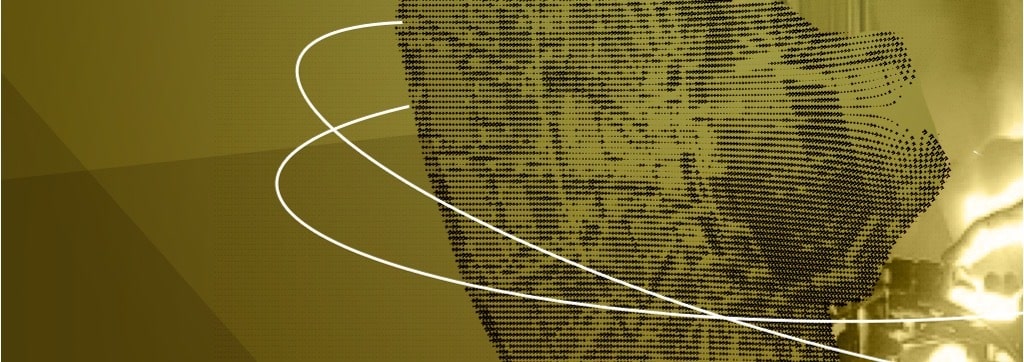Ricardo Arévalo and his colleagues have developed a prototype miniaturised instrument that could detect and identify complex organic molecules that could indicate the presence of life on other planets and moons in our Solar System. Their ‘Orbitrap-Laser Desorption Mass Spectrometry’ instrument is a fraction of the size and weight of its predecessors and could be used on future space exploration missions such as NASA’s Artemis programme and the Enceladus Orbilander.
The search for life elsewhere in our Solar System is a major subject of study. Several missions are planned for the coming decades, for example to explore planetary bodies such as Enceladus (a moon of Saturn) and Europa (a satellite of Jupiter). These moons have large underground reservoirs of water that could potentially harbour forms of life. For missions targeting these planetary bodies, it will not only be important to be able to detect simple organic molecules, but also to recognise a variety of biomarkers, such as proteins and complex biostructures. These can be produced by different types of micro-organisms.
Combining laser and spectrometer
Miniaturised mass spectrometers for planetary exploration are not new, dating back to the 1970s with the Apollo 15 mission. In the context of life detection and astrobiology, these instruments have been used to detect and identify volatile organic substances from beneath the surface of Mars, in the plumes of Enceladus and in the atmosphere of Titan. However, to date, no deployed mass spectrometer has analysed complex non-volatile organic molecules such as peptides and proteins.
Larger, more complex molecules are more likely to have been created by living systems.
Laser Desorption Mass Spectrometry (LDMS) could be just the thing. This technique uses a focused ultraviolet laser beam to desorb and ionise organic molecules, enabling their chemical composition to be determined on the basis of their mass-to-charge ratio. The advantage of this technique? The laser light can be focused on a small spot on the sample surface, allowing grains, dust particles and other micron-scale structures to be accurately characterised, and ‘chemical maps’ can be collected by scanning the laser beam across the sample surface. The LDMS also minimises contact between the instrument and the sample, reducing the risk of sample contamination – a significant problem in astrobiology.
Ricardo Arévalo and his colleagues’ new instrument combines LDMS with an Orbitrap analyser, a mass spectrometer invented in the 1990s by team member Alexander Makarov (who now works at Thermo Fisher Scientific in Germany). During operation of the instrument, ions desorbed from the sample are directed towards this analyser, which then traps them in orbits around an electrode. The movements of the ions can be tracked and this information analysed to determine the mass of the ions. This mass data can then be used to identify the molecular formulae of the organic components in the sample.
Detecting more complex organic molecules
“Our instrument integrates a pulsed UV laser system that efficiently ‘zaps’ materials and an analyser that separates chemical species from the sample according to their respective masses,” explains Ricardo Arévalo. Together, these two subsystems enable the detection and, more importantly, the unambiguous identification of larger and more complex organic molecules, which are more likely to be of biological origin. “It’s important to be able to detect larger molecules,” he explains, “because smaller organic compounds such as amino acids, for example, are more equivocal signatures of life forms.”
“Amino acids can be produced abiotically, which means that they are not necessarily evidence of life,” Ricardo Arévalo details. “Meteorites, many of which are filled with these molecules, can crash onto the surface of a planet or moon and bring organic substances with them. We now know that larger, more complex molecules, such as proteins, are more likely to have been created by, or to be associated with, living systems.”
The new instrument combines LDMS and Orbitrap, two well-established technologies, to minimise mass, volume and energy consumption. The instrument weighs less than 8 kg (compared with around 180 kg for laboratory equivalents) and measures just a few centimetres. However, it has the same ultra-high mass resolution capability as larger commercial systems and can detect biosignatures of molecules at concentrations that would be expected in the subsurface of Europa and Enceladus.
Improving astrobiology
Ricardo Arévalo hopes to send the device into space in the next few years and deploy it on a planetary target. He sees the prototype as a “precursor” for other future instruments based on LDMS and Orbitrap and believes it has the potential to significantly improve the way in which the geochemistry or astrobiology of a planetary surface is studied.
“Our instrument provides access to a wide range of physical and chemical signatures reflecting life, including stratifications representing fossilised microbial communities; minerals produced by biological compounds; organic compounds such as proteins, nucleotides [components of DNA] and lipids [constituents of cell membranes].”
Our instrument provides access to a wide range of physical and chemical signatures reflecting life.
“The completion of this laser mass analyser demonstrates the maturity of the instrument and shows that the technology is ready to explore extraterrestrial planetary environments. It is small, energy-efficient and robust enough to be deployed in environments such as Enceladus and Europa to search for signs of extraterrestrial life. Its development has involved years of international collaboration with our partners at the Laboratoire de Physique et Chimie de l’Environnement et de l’Espace in Orléans, France, and Thermo Fisher Scientific in Germany, and I am particularly proud of the number of early career researchers who have contributed so centrally to this study.”
The next step for his team is to understand how the new instrument can complement the capabilities of other state-of-the-art instruments, such as those currently operating on the surface of Mars. « This will help us to design the most complete and compelling payload suite for future astrobiology missions, » says Ricardo Arévalo.
Isabelle Dumé
References:
https://www.nature.com/articles/s41550-022–01866‑x
https://www.liebertpub.com/doi/10.1089/ast.2022.0138








